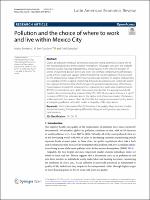Pollution and the choice of where to work and live within Mexico City

Fecha de publicación
2019-11-04Author
Fontenla, Matías
Goodwin, M. Ben
Gonzalez, Fidel
Formato
application/PDF
URL del recurso
http://hdl.handle.net/11651/4042Idioma
eng
Acceso
Acceso abierto
Compartir
Metadata
Show full item recordAbstract
Global air pollution continues to increase across the world, and Mexico City is one of the most polluted cities in the western hemisphere. This paper considers the tradeoff between wages, housing characteristics, and air quality in the conjoint decision of where a household decides to live and work. We estimate compensating differentials using a three-stage least squares (3SLS) instrumental variable approach that accounts for the simultaneous nature of the housing and wage markets. To address endogeneity, we capitalize on the localized relationship between air pollution and rainfall. We assemble a dataset for Mexico City which includes the actual transacted value of the house, house features, household socioeconomic characteristics, particulate matter pollution (PM10) concentrations, and rainfall. Our results indicate that the average household needs to be compensated by approximately US$ 1007.54 per year to tolerate a 1 µg/m3 increase in PM10. Our estimates are on the higher end of previous studies. If estimates under-represent the value of clean air, then this discourages government policy aimed at mitigating pollution, with all its health and quality of life implications.
Editorial
Centro de Investigación y Docencia Económicas
Derechos
La revista Latin American Economic Review autoriza a poner en acceso abierto de conformidad con las licencias CREATIVE COMMONS, aprobadas por el Consejo Académico Administrativo del CIDE, las cuales establecen los parámetros de difusión de las obras con fines no comerciales. Lo anterior sin perjuicio de los derechos morales que corresponden a los autores.
Tipo
Artículo

